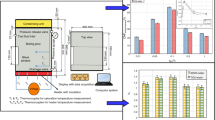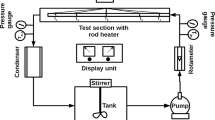Abstract
TiO2/water nanofluids were prepared and tested to investigate the effects of an ionic additive (i.e., nitric acid in this study) on the critical heat flux (CHF) behavior in pool boiling. Experimental results showed that the ionic additive improved the dispersion stability but reduced the CHF increase in the nanofluid. The additive affected the self-assembled nanoparticle structures formed on the heater surfaces by creating a more uniform and smoother structure, thus diminishing the CHF enhancement in nanofluids.












Similar content being viewed by others
References
You SM, Kim JH, Kim KH (2003) Effect of nanoparticles on critical heat flux of water in pool boiling heat transfer. Appl Phys Lett 83:3374–3376
Vassallo P, Kumar R, D’Amico S (2004) Pool boiling heat transfer experiments in silica-water nano-fluids. Int J Heat Mass Transf 47:407–411
Zuber N (1959) Hydrodynamic aspects of boiling heat transferPhysics and Mathematics AEC
Milanova D, Kumar R (2005) Role of ions in pool boiling heat transfer of pure and silica nanofluids. Appl Phys Lett 87:244107
Kim H, Kim J, Kim MH (2006) Experimental study on CHF characteristics of water-TiO2 nano-fluids. Nuclear Eng Tech 38:61–68
Kim SJ, Bang IC, Buongiorno J, Hu LW (2007) Surface wettability change during pool boiling of nanofluids and its effect on critical heat flux. Int J Heat Mass Transf 50:4105–4116
Coursey JS, Kim J (2008) Nanofluid boiling: the effect of surface wettability. Int J Heat Fluid Flow 29:1577–1585
Kwark SM, Kumar R, Moreno G, Yoo J, You SM (2010) Pool boiling characteristics of low concentration nanofluids. Int J Heat Mass Transf 53:972–981
Kwark SM, Moreno G, Kumar R, Moon H, You SM (2010) Nanocoating characterization in pool boiling heat transfer of pure water. Int J Heat Mass Transf 53:4579–4587
Lee S, Choi SUS, Li S, Eastman JA (1999) Measuring thermal conductivity of fluids containing oxide nanoparticles. J Heat Transf 121:280–289
Kim H, Ahn HS, Kim MH (2010) On the mechanism of pool boiling critical heat flux enhancement in nanofluids. J Heat Transf 132:061501
Wang C-C, Zhang Z, Ying JY (1997) Photocatalytic decomposition of halogenated organics over nanocrystalline titania. Nanostruct Mater 9:583–586
Mandzy N, Grulke E, Druffel T (2005) Breakage of TiO2 agglomerates in electrostatically stabilized aqueous dispersions. Powder Tech 160:121–126
Holman JP (2001) Experimental methods for engineers, 7th edn. McGraw-Hill, New York
Kuwabara S (1959) The forces experienced by randomly distributed parallel circular cylinders or spheres in a viscous flow at small Reynolds numbers. J Phys Soc Jap 14:527–532
Li D (2004) Electrokinetics in microfluidics. Elsevier, London
Hunter RJ (1987) Foundations of colloid science, 1st edn. Clarendon Press, Oxford
Haramura Y, Katto Y (1983) A new hydrodynamic model of critical heat flux, applicable widely to both pool and forced convection boiling on submerged bodies in saturated liquids. Int J Heat Mass Transf 26:389–399
Das SK, Putra N, Roetzel W (2003) Pool boiling characteristics of nano-fluids. Int J Heat Mass Transf 46:851–862
Wen DS, Ding YL (2005) Experimental investigation into the pool boiling heat transfer of aqueous based gamma-alumina nanofluids. J Nanopart Res 7:265–274
Jung JY, Kim YW, Yoo JY, Koo J, Kang YT (2010) Forces acting on a single particle in an evaporating sessile droplet on a hydrophilic surface. Anal Chem 82:784–788
Jung JY, Yoo JY (2009) Thermal conductivity enhancement of nanofluids in conjunction with electrical double layer (EDL). Int J Heat Mass Transf 52:525–528
White SB, Shih AJ, Pipe KP (2010) Effects of nanoparticle layering on nanofluid and base fluid pool boiling heat transfer from a horizontal surface under atmospheric pressure. J Appl Phys 107:114302
Kim H, Kim M (2009) Experimental study of the characteristics and mechanism of pool boiling CHF enhancement using nanofluids. Heat Mass Transf 45:991–998
Jung JY, Kwak HY (2006) Effect of surface condition on boiling heat transfer from silicon chip with submicron-scale roughness. Int J Heat Mass Transf 49:4543–4551
Acknowledgments
This work was supported by a grant from the Kyung Hee University in 2010. (KHU-20100605).
Author information
Authors and Affiliations
Corresponding author
Rights and permissions
About this article
Cite this article
Jung, JY., Kim, H. & Kim, M.H. Effect of ionic additive on pool boiling critical heat flux of titania/water nanofluids. Heat Mass Transfer 49, 1–10 (2013). https://doi.org/10.1007/s00231-012-1055-1
Received:
Accepted:
Published:
Issue Date:
DOI: https://doi.org/10.1007/s00231-012-1055-1




